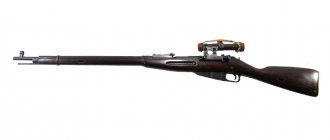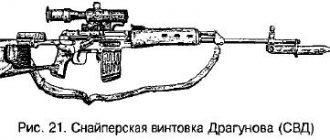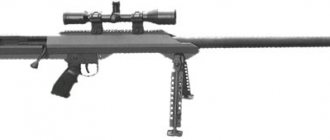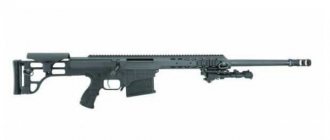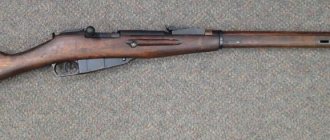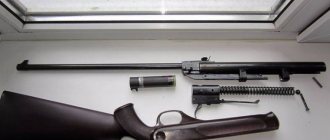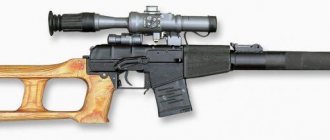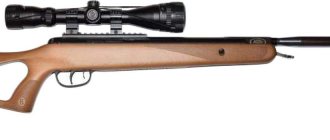The history of the creation of the SVDK sniper rifle
For a long time, the development of large-caliber sniper rifles was not given enough attention. Based on the accumulated military experience, it was concluded that the troops need to have sniper rifles designed to destroy enemy personnel protected by body armor. For development, it was decided to take the SVD sniper rifle and the Tiger-9 carbine as a basis.
At first it was planned to simply adapt the sniper rifle to a nine-millimeter cartridge. However, this turned out to be impossible. The use of a more powerful cartridge caused design changes in the most important components of the weapon. It was necessary to create a new bolt group. It was planned that the weapons being created would occupy an intermediate place between types of weapons. Using 7.62 and 12.7 mm cartridges.
The increase in the strength of the weapon components led to the weight of the rifle by 2 kg. However, the dimensions have changed slightly.
The development of this weapon took place within the framework of the Burglar R&D project. The results were presented in 2006. After state tests were carried out, the Dragunov Large-caliber Sniper Rifle (SVDK) was chosen and its mass production was established.
It should be noted that Russian weapons terminology refers to large-caliber small arms with a cartridge caliber over 9 mm.
The design of the SVD rifle was used during development. Although it was used for smaller caliber cartridges, the SVD and SVDK designs had similar elements. The main differences are a thicker barrel and a more massive carbine. Comparing these rifles, shooters note the higher stability of the SVDK. On the other hand, when using it, fatigue increased due to a significant increase in weight.
Comments:
| 11/05/2008 Comments: Alexey Akinshin Didn’t serve, health didn’t allow it. But I want it that way. If there were organizations for men of non-conscription age to prepare for non-combatant service, I would go. I came here and was so drawn to hold the SVD in my hands... Thanks for the detailed instructions. |
| 05/27/2008 Comments: oskar the material was well selected and all the details are clear down to the smallest detail, but the photo is not enough for a complete disassembly of what and how, and well done |
| previous article |
The article presents the most widely used methods of combining a pistol with a hand-held flashlight to fire and simultaneously illuminate the target.Sniper training. 9 mm sniper rifle VSK – 94
Purpose and technical characteristics. The main parts and mechanisms of the rifle, the principle of operation. Disassembly and assembly.
Performance characteristics of a sniper rifle
| Characteristic | Parameter |
| Caliber | 9.3 mm |
| Barrel length | 620 mm |
| Penetrating power | at a distance of 100 m it penetrates armor 1 cm thick |
| Ammunition type | 7N33 cartridges (9.3 x 64 mm) |
| Magazine capacity | 10 |
| Shot speed | up to 770 m/s |
| Rate of fire | 20 rounds per minute |
| Bullet range | 1200 |
| Aim | front sight, dovetail |
| Weight | 6.5 kg |
At a distance of 100 m, a bullet is capable of penetrating a centimeter-long armor plate with an 80% probability. Without an optical sight and bipod, the weapon weighs 6.5 kg. The length of the weapon is 1250 mm, and the barrel is 620 mm.
The rifle is self-loading. The bolt is retracted using exhaust powder gases. The maximum available sighting range is 600 m. The bullet flight range reaches 1200 m. A 10-round box-type magazine is used. The bullet's flight speed is 770 m/sec. The rate of fire is 20 rounds per minute.
The rifle is designed to destroy the enemy using body armor of classes NIB IV-V, as well as those who are behind unarmored barriers or in light shelters.
The folding stock allows you to reduce the size of the weapon, which makes the rifle more convenient for transportation. It is convenient to carry it in armored vehicles or to take the weapon with you during an airdrop.
The absence of a bayonet does not allow the rifle to be used for hand-to-hand combat. However, even if such a possibility were provided, it is unlikely that it would be in demand.
Killer sporty design
The fact that Dragunov devoted a lot of time to the development of high-precision sports small arms, such as the TsV-50, MTsV-50, Zenit, Strela and Taiga rifles, which brought many medals to Soviet shooters, certainly affected the appearance of his sniper brainchild .
An ergonomic frame stock with a pistol grip, a removable butt cheek, a universal optical sight reticle with a lateral correction scale and a rangefinder scale, a light filter, a retractable hood, a barrel rifling pitch of 320 mm, excellent balance and much more in the SVD device - a direct consequence of Dragunov’s “sports” experience . Experience that made it possible to create a self-loading sniper weapon that is unique in its characteristics. The fact that the SVD and its clones are still in service with the armies of at least 32 countries, including Russia, only confirms this thesis.
A sniper weapon is a complex that includes not only a rifle, but also a cartridge and an optical sight. Initially, the SVD, created for the standard Mosin 7.62 mm rimmed cartridge, did not have a special sniper cartridge. This was adopted only in 1967 and immediately improved the accuracy of the SVD, although not to the level of “bolts”.
However, the introduction of armor-piercing incendiary bullets into the range of ammunition used by a sniper rifle showed that with them the dispersion almost doubles. This was considered completely unacceptable. This shortcoming was “cured” in 1975 by changing the barrel rifling pitch from 320 mm to 240 mm. The accuracy of firing with armor-piercing incendiary bullets has increased noticeably. But the accuracy of fire with conventional and sniper ammunition dropped by 25%. This was considered quite tolerable for the SVD, based on the principle “Even if we don’t hit the eye, we’ll definitely hit the head!”
Although the PSO-1 optical sight developed for the SVD provided the rifle with a “certified” sighting range of 1300 meters, the real chance of hitting the target with the first shot disappeared for most SVD users already at a distance of 800 meters. At a greater distance, it is recommended to shoot from the SVD only at a group target, or to conduct harassing fire. However, the most qualified or, as an option, the luckiest shooters managed to repeatedly exceed the “passport” performance characteristics of rifles.
For example, in Afghanistan and Chechnya, hits from the SVD with the first shot were recorded more than once on a target located 1000–1100 meters away from the shooter. Vladimir Ilyin , who fought in Afghanistan, managed to “take out” a dushman from an SVD at a distance of 1,350 meters, and in 1989, a Salvadoran partisan used the same rifle to “kill” a jet attack aircraft with a single shot.
In addition to the standard PSO-1, the rifle could also be equipped with NSPUM or NSPU-3 night sights.
SVDK structure
A folding stock is used. It can be removed by moving to the right. The Hyperon (1P70) is used as an optical sight. This rifle represents a further development of the SVD. It used a bolt group, receiver, and gas tube designed for a more powerful cartridge.
The rear part of the barrel is covered with a special perforated casing. It is designed to reduce mechanical stress on the barrel. Under the barrel there is a tire in the form of a half-pipe, to which a bipod is attached. The flame arrester design is similar to that used in the SVD. The bipod is integral, but can be folded if necessary.
Here you can use a sniper scope or an open adjustable sighting device. Hyperon has 3-10x magnification available. It is allowed to use the 1PN112 sight instead of the standard one. "Hyperon" has range adjustment. This scope has a relatively high cost. Its use significantly makes the weapon heavier.
The rifle has a pistol grip. The folding stock has a rubber butt pad designed to reduce recoil when fired. There is no possibility of installing a bayonet on the barrel. On the left side there is a rail for installing sighting optics.
The automation works as follows. Part of the exhaust powder gases is removed from the barrel. They exert pressure on the piston rod. He transfers force to the bolt, pushing it.
The recoil of the bolt causes the spring to compress. At the same time, the cartridge case is extracted and the trigger is cocked. The action of the spring forces the bolt to return to its original place in the firing position. During the movement, a new cartridge is snatched from the chamber.
After it is chambered, fixation occurs by turning the bolt cylinder. The rifle has a safety lever that locks the bolt and the firing pin entrance.
Without relying on others
The problem with pinching the barrel was quite effectively treated by the famous Russian gunsmith Gennady Kozhaev, whom the shooters respectfully call “Mikhalych”. For his work, Gennady Mikhailovich quoted a price commensurate with the price of a rifle, and a period of six months. While the price was still acceptable, the timing was categorically not acceptable. In addition, the second problem of the SVD was not solved - installing optics on the side rail. This problem is familiar to everyone who tries to shoot accurately from an SVD at long distances: the rifle collects a group, but every day this group can end up in a new place, the average point of impact - the STP - “walks” around the target. So I had to take on the matter myself. Having suffered, I removed all the accessories from the barrel of my SVD, and I was left with a bare barrel. I made the first version of my rifle in a rough version, using welding, pieces of steel and a forend from HK417. This Frankenstein weighed six kilograms, but the main thing was that he started shooting!
The earliest version of the SVD Vlasenko, in which you can still guess the donor, is the SVDS with a folding butt. The Demon robotic thermal imaging sight gives you a multiple advantage at night over an enemy who does not have such a sight. True, it costs as much as several sniper rifles.
For the next three months, I drew a kit - a set of parts that replaced the factory ones and eliminated the problems described. Then I spent another three months looking for someone who would undertake to make it and finally milled the first version of the chassis. Initially, I thought of making a SAGE EBR chassis for the American M14 automatic rifle, which was in service with the US Army in 1950-1960. It is a large “cup” in which the rifle is placed. But to do this, it would be necessary to change many additional parts: the cover pin, the fuse box - essentially, the number of changed parts was “pulled” onto the new rifle and definitely crossed out the possibility of independently installing the chassis. And this was one of the fundamental points; the user should be able to install the chassis himself using available tools without affecting the main parts.
Ammunition for a sniper rifle
A cartridge with a caliber of 9.3 mm and a length of 64 mm was developed. The basis for the development was a cartridge for a hunting rifle from Brenneke. The European prototype was developed in 1910. Its author was the German master Wilhelm Brenneke. This ammunition was intended for the Mauser repeating rifle.
At the time of its creation, it was considered one of the most powerful European nine-millimeter caliber cartridges. The main area of its use was hunting large animals.
The bullet has a mass of 16.6 g. When leaving the barrel, the initial speed is 750 m/sec. The mechanical energy of the bullet at this moment is 5 kJ. The brass sleeve was developed by TsNIITOCHMASH in 1986. At first it did not find application, but it was remembered during the development of the SVDK. The cartridge is called 7N33.
Legend replaces legend
When describing the SVD, it must immediately be said that the future legend has replaced another legend - the long-existing Mosin rifle in its sniper version. The battles of the late Great Patriotic War showed that the practice of using sniper versions of self-loading rifles - our SVT or the German Walther G-43 - was fully justified. In the hands of experienced fighters, such rifles become truly deadly weapons. The 309 killed Nazis from Lyudmila Pavlichenko’s SVT perfectly illustrate this thesis.
SVD scheme
Nevertheless, the “self-loading” guns from the war did not meet the requirements for them, primarily in terms of simplicity and reliability. New weapon systems chambered for the 7.62x39 intermediate cartridge were less long-range, and the only non-automatic carbine chambered for this cartridge, the SKS, was not suitable for the role of a sniper. The upward extraction of the cartridge case and the insufficiently powerful cartridge, as well as the rapid displacement from the troops by faster-firing brothers - all this excluded the carbine from the list. Therefore, accurate shooters of motorized rifle companies continued to arm themselves with Mosin rifles. Of course, this could not continue; a big war that could happen would require new solutions in the field of creating precision weapons.
This solution was found by the hereditary Russian gunsmith Evgeniy Fedorovich Dragunov. During the war and immediately after its end, he worked in weapons production and by the end of the 50s he was already an experienced design engineer. He had several developments behind him, including the successful S-49 sporting rifle.
Soldier with SVD in Afghanistan
The military had long felt the need for a new precision rifle, and in 1957 a competition for such a weapon was launched. Dragunov and his group of Izhevsk gunsmiths faced very serious competitors - the famous Simonov himself with his Klimovites and Konstantinov from Kovrov. All three rifles presented reached the finals, and in tough tests the future SVD came out on top.
Disassembling the rifle
Disassembly may be incomplete or complete. In the first case, we are talking about lubricating and cleaning weapons. It is also used for visual inspection of weapons to ensure that they are in good working order. If it is very dirty, it will require complete disassembly for cleaning and lubrication.
When performing the procedure, you must sit on a clean table. If disassembly is carried out in the field, it must be done on a sufficiently large piece of clean material. It must be remembered that disassembling too often is unacceptable. Since it increases wear on the weapon and can lead to damage.
When performing the procedure, during disassembly you need to place the parts in the order in which they are removed from the mechanism. It is important to handle them with the utmost care. Do not perform actions using significant force, as this can lead to damage. You cannot stack parts on top of each other. It is important to ensure that they do not hit hard objects.
When performing partial disassembly, you must perform the following steps:
- First you need to separate the store.
- It is important to ensure that there is no round in the chamber. Otherwise, accidental operation may occur, which will lead to tragic consequences. For inspection, the fuse is lowered down, the charging handle is pulled all the way back and the chamber is inspected. Then they release it so that it falls into place.
- It is necessary to separate the optical sight. To do this, lift the clamping screw flag. Then it is turned towards the eyecup until it stops. After this, the sight is moved back.
- Disconnect the butt.
- The receiver cover together with the return mechanism is separated from the mechanism. To do this you need to do the following. The lid lock is turned back until it snaps onto the latch. After this, the rear part of the receiver cover is lifted up.
- Now you need to separate the bolt frame and bolt. To do this, it is pulled back to the limit and raised.
- The bolt is completely separated from the bolt frame.
- Now you need to remove the trigger mechanism. To do this, you first need to place the fuse in a vertical position. After this, it is separated from the receiver. Now you need to grab the trigger guard and pull it down. After this, the trigger can be easily separated from the box.
- Now you need to separate the barrel linings. You need to grab the contact of the upper thrust end and press it against the gas tube. Then you need to turn it all the way. After this, the ring is moved forward. It is separated from the barrel by pressing the barrel lining back and then moving it to the side.
- It is necessary to disconnect the gas piston and the pusher with the spring. In order to do this, the pusher is pulled back. Then the front end is removed from the piston seat. By moving forward it can be separated and disconnected from the gas tube.
Assembly is performed in reverse order. The parts are taken in the reverse order to the one in which they were laid out. Assembly is carried out in the following sequence:
- The spring is put on the rear end of the pusher. The front end is inserted into the gas tube. Press the spring and insert the pusher into the channel of the aiming block. It is pulled back as far as possible, and the gas piston is inserted into the pipe, then pressed with the front end of the pusher.
- Attach the barrel linings. The rear end is inserted into the lower thrust ring. By pressing down, the lining is attached to the barrel. After this, slide the upper thrust ring.
- Put the trigger mechanism in place. It is inserted into the receiver and pressed. The fuse axis is inserted into the hole in the receiver. The fuse must be installed in a vertical position. Then it must be pressed and turned down until it stops.
- The bolt is attached to the bolt frame. It is placed in a socket on the bolt frame, then turned and moved forward.
- You need to perform the action while holding the shutter in the forward position. It is inserted in accordance with the protrusions of the bolt frame.
- Replace the bolt box cover along with the return mechanism. The latter is inserted into the channel of the bolt frame. You need to compress the return spring, then insert the tabs at the front into the corresponding slots on the lower thrust end. You need to press on the lid, ensuring it fits snugly. The lid lock is turned forward until it stops.
- Attach the butt.
- Install the optical sight in place. To do this, combine the grooves on the sight and those on the bracket. The sight is advanced all the way. After this, the clamping screw is tightened, rotating towards the lens. As a result, its bend should fall into the corresponding groove.
- They put the store in place. To do this, place it in the groove and turn it slightly towards itself until it clicks into place.
Complete disassembly is required in rarer cases than the incomplete disassembly described here.
Accurate shooter
The Dragunov sniper rifle was not created for snipers in the modern sense of the word, but for the most accurate, accurate shooters in an ordinary military unit.
The main task of modern snipers, who usually work in pairs or groups, is to hit important targets with minimal ammunition consumption at maximum range. They mainly use bolt-action rifles with manual reloading, very powerful cartridges, expensive sighting systems, rangefinders and weather stations. Accurate shooters work on the move, in battle formations, at distances of up to 600 meters, and the main requirements for their weapons are accuracy and high density of fire. It was precisely for these characteristics that the SVD was created. How you can adapt the SVD to new realities and increase accuracy can be seen in the example of the Vlasenko rifle. A) offers sighting devices, which in modern combat are no less important than the weapon and ammunition itself. And for accurate shooters, their importance is generally difficult to overestimate, since in terms of high-precision shooting skills they are much inferior to professional snipers.
Vampire ST is a lightweight and compact in-line ballistic calculator. It easily integrates with a tactical optical sight (in the photo with one of the best domestic sights Dedal DH 3−12 x 50), interfaces with the mechanism for entering vertical corrections and provides instant automatic calculation of vertical and horizontal corrections. The built-in OLED display displays the calculated correction value, the distance to the target, as well as the accurate shot distance for the current position of the vertical correction drum. The shooter has two options: if time permits, enter the necessary corrections or instantly make the desired offset, guided by the picture on the display. Vampire ST is optionally equipped with an IWT laser rangefinder, which communicates with the ballistic module via cable or radio. As a result, the shooter only needs to aim at the target, press the rangefinder button, enter corrections or adjust the crosshair to the desired values and press the trigger.
Demon is the younger brother of the Sheitan automated thermal imaging sighting system, which we have already talked about more than once on the pages of our magazine. And if Sheitan is intended for high-quality snipers (and not all of them can afford this technical miracle), then Demon is the ideal solution for our precision shooters. The small complex contains a thermal imaging sight, a highly selective laser rangefinder, a photo and video recording device, a ballistic calculator, a navigation complex and (optional) a weather station. The list of everything the Demon can do takes up a whole page, but in practice it looks like this: you point the crosshairs at the target, pull the trigger, and the bullet hits exactly where the crosshairs were. Calculation of external ballistics, range to the target, target elevation angle, the influence of weather conditions, wind and even derivation and the Coriolis effect - all this is instantly done by the Demon itself. It looks like science fiction, but we shot - this is reality. But why then is this not a real sniper’s device? The fact is that Demon detects a target at a distance of 1500 m, but can reliably identify it only at 180 m. It is at such distances in complete darkness that precision shooters work.
Checking the accuracy and effectiveness of shooting from the OSV-96 rifle
In order for shooting from the OSV-96 rifle to be truly effective, it must be zeroed. You need to know that ammunition from different manufacturers can produce different accuracy. For zeroing, you need to take several boxes of cartridges from different manufacturers. First you need to shoot cartridges from one manufacturer, then (at another target) cartridges from another manufacturer.
You need to shoot from a bipod in a prone position. Shooting is carried out at various distances, starting from 100 meters. When shooting, you need to remember that the recoil of a large-caliber rifle, despite the presence of a rubber butt pad, will be very significant. The weapon is sighted using both an open sight and an optical or night sight.
Before using the iron sight, it must be configured. The procedure for setting up the sight is described in detail in the instructions for the weapon, which is included in the kit.


